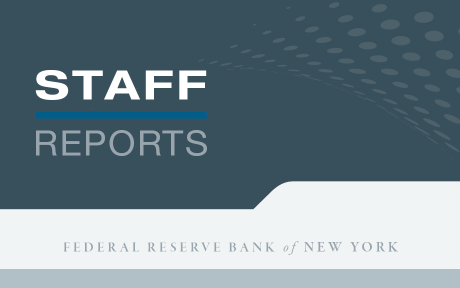
There has been a lot of interest in firms’ pricing decisions in the past few years—both during the inflation surge of 2021-23 and in the more recent rounds of tariff increases. In this post, we let firms speak for themselves about what factors they consider when adjusting prices in response to various shocks. The analysis is based on an ongoing research project, joint with the Atlanta and Cleveland Federal Reserve Banks, on how businesses set prices and the extent of passthrough of cost increases. In particular, we leverage the qualitative portion of the study based on open-ended interviews with senior decision-makers on how they approach pricing decisions in their firms. Rather than a uniform approach, a very nuanced picture emerges of businesses trying to balance competing objectives while keeping an eye on demand conditions for their products as well as on their direct competitors’ behavior in the market.
Businesses Trade Off Profit Margins and Sales Volume in Deciding Whether to Pass Through Cost Increases
As described in a previous Liberty Street Economics post, we adopted a two-stage approach to study firms’ pricing behavior, using both qualitative and quantitative methods. Here we focus on the qualitative part of the analysis, based on open-ended interviews with thirty-three business decision-makers (CEOs, CFOs, and business owners) from a variety of industries in 2021 to talk about their price-setting behavior. The second stage of the analysis consisted of a quantitative survey of about 700 businesses fielded in late 2022 and early 2023 across the Second, Fourth and Sixth Federal Reserve districts. The overall findings of the project so far are discussed here.
Virtually all firms in our sample have a target margin for their operations overall. This is usually expressed as a percent target, although a couple of firms (commodity producers and retailers) target a fixed dollar margin. But even though having an explicit target margin is widespread, this is generally just a benchmark. Almost none of our interviewees mechanically follow a strict cost-plus pricing rule in all circumstances: instead, many factors influence the actual margin a given business is able to achieve.
One key consideration for firms in deciding whether (and to what extent) to pass through cost increases to their customers is the trade-off between margins and sales volumes. Often, a business will accept a lower margin to protect volume. For example, a fluff and pulp manufacturer stated:
As an organization, we’re tasked with getting as much as we can from a contribution margin perspective for every time and each amount of time allotted to that machine. But also … there’s risk/reward. You can’t push that too high, because you’ll sacrifice volume.
Along similar lines, an equipment manufacturer stated that their business would only increase prices by 2.5 percent following cost increases of 4 percent, and explained that decision as follows:
We have a lot of pricing power, but there is still a point where somebody’s like, ‘Hey, I bought one of these two years ago and it’s 15 percent more expensive now. What’s going on?’ We do get … a little bit of pushback. We’re a bit thoughtful about trying to go after too much too fast.
Conversely, one construction company explained that they might raise margins above their 5 percent target if they have already met their annual sales goal:
You know what’s going to drive our margins up? When we just don’t feel like we don’t need to add any more work, right? If we get six months through this year and that $600 million that we had in front of us is already converted, just because we can take a chance on not winning another piece of business, we’re going to take some of that 5 percent work and make it 7 percent.
Demand Conditions Affect the Extent of Pass-Through
As the previous quotes suggest, the trade-off between margins and sales and the extent of cost pass-through are heavily influenced by the demand conditions faced by a business. Most of our interviews were conducted during a period of generally strong demand as the economy emerged from the COVID pandemic. This strong demand made it easier for firms to maintain or even increase margins in response to higher costs. As a residential real estate developer put it:
So, and again, the good news is that [the] market has allowed us to raise prices, in effect, more than what the cost increases have gone up. But it isn’t necessarily so. It’s not kind of, the cause and effect isn’t, ‘Hey, our costs have gone up so let’s raise prices.’ You know, I mean, if the market demand wasn’t strong enough to raise prices, we’d be stuck with lower margins.
Perhaps not surprisingly, firms are generally aware that demand for their products is downward-sloping and take into account demand elasticities in their pricing decisions. Indeed, some firms explicitly experiment to get a better sense of the slope of the demand curve they face. One producer of dairy ingredients said:
We’re always constantly trying to push the envelope to see what the market will bear … until you start losing a few [customers], you haven’t achieved the maximum price in the marketplace.
And one retailer told us:
We have done some testing … where we have pushed the upper limit in one or two stores … Where we took, basically, a 7 percent increase all at once, to see what the consumer would do, and they retracted.
Interestingly though, even firms who referred to the concept of “elasticities” do not seem to use them to set markups over costs, as standard theory would suggest: rather, a high elasticity is cited as a reason to refrain from passing through an increase in cost.
Businesses Watch Their Competitors Carefully
Another important determinant of firms’ pricing decisions is the behavior of their competitors. One tire manufacturer said:
The biggest consideration here has been what is the competition doing.… We want to remain price relevant in the market, and understand how much of true cost can we mitigate, or manage, but really it’s what is the competition doing.… If the competition is going 2 percent we don’t want to go out and say, ‘well we really need to pass on four [percent]’ because it won’t hold in the market.
Another manufacturer put it quite poetically:
It’s an industry where competition watches each other … it’s a very fine balance and a well-orchestrated dance that we watch each other very closely.
And a gas station owner said succinctly:
It’s the competition, whatever is going on in the local market. We try to maximize our profits and protect our volumes.
This mutual watching among competitors within an industry generates a degree of “strategic complementarity” among businesses: In other words, firms may be more likely to “cross the street in unison” when making pricing decisions. This dynamic may amplify price fluctuations within an industry as firms move in tandem with their competitors, especially when they face common shocks; it may also dampen price fluctuations when firms are hit by shocks that are more firm-specific.
Firms View Labor Cost Increases Differently than Other Input Cost Shocks
Finally, an interesting asymmetry in pass-through was revealed in our interviews regarding labor cost increases relative to other cost increases. A sizable share of interviewees (roughly one quarter, all of them in goods producing firms) stated that labor cost increases do not have a first order impact on price increases for their products. Rather, they typically try to offset those labor cost increases through productivity gains and other efficiencies in their production processes. One respondent said:
We’ve been able to maintain quality, lower our costs through … improvements in our operational capabilities. That’s typically how we think about capturing wage growth, is that if our wages are increasing at three percent annually, we should be aiming for a five percent in sort of efficiency improvements.
Similarly, a steel manufacturer told us:
Labor cost is going up. There are things that we have to do to get more efficient, to try to offset that.
The muted response of these firms’ prices to labor cost increases is consistent with other recent research: “The Missing Inflation Puzzle: The Role of the Wage-Price Pass-Through,” and “The Changing Link Between Labor Cost and Price Inflation in the United States.” In contrast, firms are much more likely to pass through raw materials costs, often via contractual indexation: for a packaging business, “the only adjustments that are made during a contract in terms of pricing has to do with the increases or decreases in raw materials from some baseline that was established at the outset of the beginning of the contract.”
Conclusion
Our ongoing project has uncovered some fascinating nuances in how businesses approach their pricing decisions. Virtually all firms have a margin target, but that target is an “aspirational” one: In practice, most firms set margins flexibly and trade off profit margins against sales volume and market share. Demand conditions, and the elasticity of demand for their products are a key factor in price setting and in the extent of pass-through of any cost increases: A stronger demand allows for a higher degree of pass-through, and vice versa. Competitors’ behavior also features prominently in a firm’s calculus regarding pricing: To the extent that businesses in an industry “watch each other carefully,” this has implications for the extent of pass-through and can potentially amplify price fluctuations as “price followers” catch up with “price leaders.” Finally, many firms—at least in goods producing sectors—are less willing to pass through labor cost increases than other input cost shocks, which may limit the passthrough of wage pressures to price inflation.
Wändi Bruine de Bruin is provost professor of public policy, psychology, and behavioral science at the Sol Price School of Public Policy at the University of Southern California (USC), and director of the USC Behavioral Science and Well-Being Policy initiative.

Keshav Dogra is an economic research advisor in the Federal Reserve Bank of New York’s Research and Statistics Group.

Sebastian Heise is a research economist in the Federal Reserve Bank of New York’s Research and Statistics Group.
Edward S. Knotek II is a senior vice president and director of research in the Research Department at the Federal Reserve Bank of Cleveland.
Brent H. Meyer is an assistant vice president and economist in the research department at the Federal Reserve Bank of Atlanta.
Robert W. Rich is the director of the Center for Inflation Research and a senior economic and policy advisor in the Research Department at the Federal Reserve Bank of Cleveland.
Raphael S. Schoenle is a professor of economics at Brandeis University.

Giorgio Topa is an economic research advisor in the Federal Reserve Bank of New York’s Research and Statistics Group.

Wilbert van der Klaauw is an economic research advisor in the Federal Reserve Bank of New York’s Research and Statistics Group.
How to cite this post:
Wändi Bruine de Bruin, Keshav Dogra, Sebastian Heise, Edward S. Knotek II, Brent H. Meyer, Robert W. Rich, Raphael S. Schoenle, Giorgio Topa, and Wilbert van der Klaauw, “How Businesses Set Prices—In Their Own Words,” Federal Reserve Bank of New York Liberty Street Economics, November 24, 2025, https://doi.org/10.59576/lse.20251124
BibTeX: View |
Disclaimer
The views expressed in this post are those of the author(s) and do not necessarily reflect the position of the Federal Reserve Bank of New York or the Federal Reserve System. Any errors or omissions are the responsibility of the author(s).












 RSS Feed
RSS Feed Follow Liberty Street Economics
Follow Liberty Street Economics